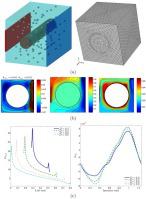Chemical Engineering and Processing: Process Intensification ( IF 3.8 ) Pub Date : 2020-06-25 , DOI: 10.1016/j.cep.2020.108010 A.I. Alsabery , M.A. Sheremet , A.J. Chamkha , I. Hashim

|
The energy transport intensification can be achieved by an addition of nanoparticles to the host liquid. Simultaneously, a location of partial heating and the velocity of moving cavity surface can be control parameters for the thermal transmission. The present research deals with a computational investigation of mixed convective energy transport within a cubical chamber saturated by nanofluids, including the impacts of cold surface motion, local heating, and central heat-conducting cylinder. The governing equations are written using the Buongiorno's nanoliquid approach with the Boussinesq approximation in primitive dimensionless variables and are solved numerically by the finite-element technique. An investigation of the nanoliquid circulation and energy transport has resulted in an extensive range of control characteristics, namely, Reynolds number, Richardson number, nanoparticle volume fraction, dimensionless radius of solid cylinder, dimensionless heat source length and the dimensionless heat source position. It has been observed that a nonlinear impact of nanoparticles volume fraction toward the energy transport strength for high Reynolds number exists. Whilst for low Reynolds number, a growth of the nano-sized particles concentration leads to the energy transference strengthening. At the same time, a rise of the inner cylinder size characterizes a diminution of the heat transport strength.
中文翻译:

包含固体圆柱体和热源的三维盖驱动立方腔体内两相纳米流体途径的能量传输
可以通过将纳米颗粒添加到主体液体中来实现能量传输的增强。同时,局部加热的位置和空腔表面的移动速度可以作为热传递的控制参数。本研究涉及在一个由纳米流体饱和的立方室内混合对流能量传输的计算研究,包括冷表面运动,局部加热和中央导热圆柱体的影响。控制方程式是使用Buongiorno的纳米液体方法,用Boussinesq逼近原始无量纲变量来编写的,并通过有限元技术进行了数值求解。对纳米液体循环和能量传输的研究导致了广泛的控制特性,即 雷诺数,理查森数,纳米颗粒体积分数,实心圆柱的无量纲半径,无量纲的热源长度和无量纲的热源位置。已经观察到,对于高雷诺数,存在纳米粒子体积分数对能量传输强度的非线性影响。尽管对于低雷诺数,纳米级颗粒浓度的增长导致能量传递增强。同时,内筒尺寸的增大表征了传热强度的减小。已经观察到,对于高雷诺数,存在纳米粒子体积分数对能量传输强度的非线性影响。尽管对于低雷诺数,纳米级颗粒浓度的增长导致能量传递增强。同时,内筒尺寸的增大表征了传热强度的减小。已经观察到,对于高雷诺数,存在纳米粒子体积分数对能量传输强度的非线性影响。尽管对于低雷诺数,纳米级颗粒浓度的增长导致能量传递增强。同时,内筒尺寸的增大表征了传热强度的减小。











































 京公网安备 11010802027423号
京公网安备 11010802027423号